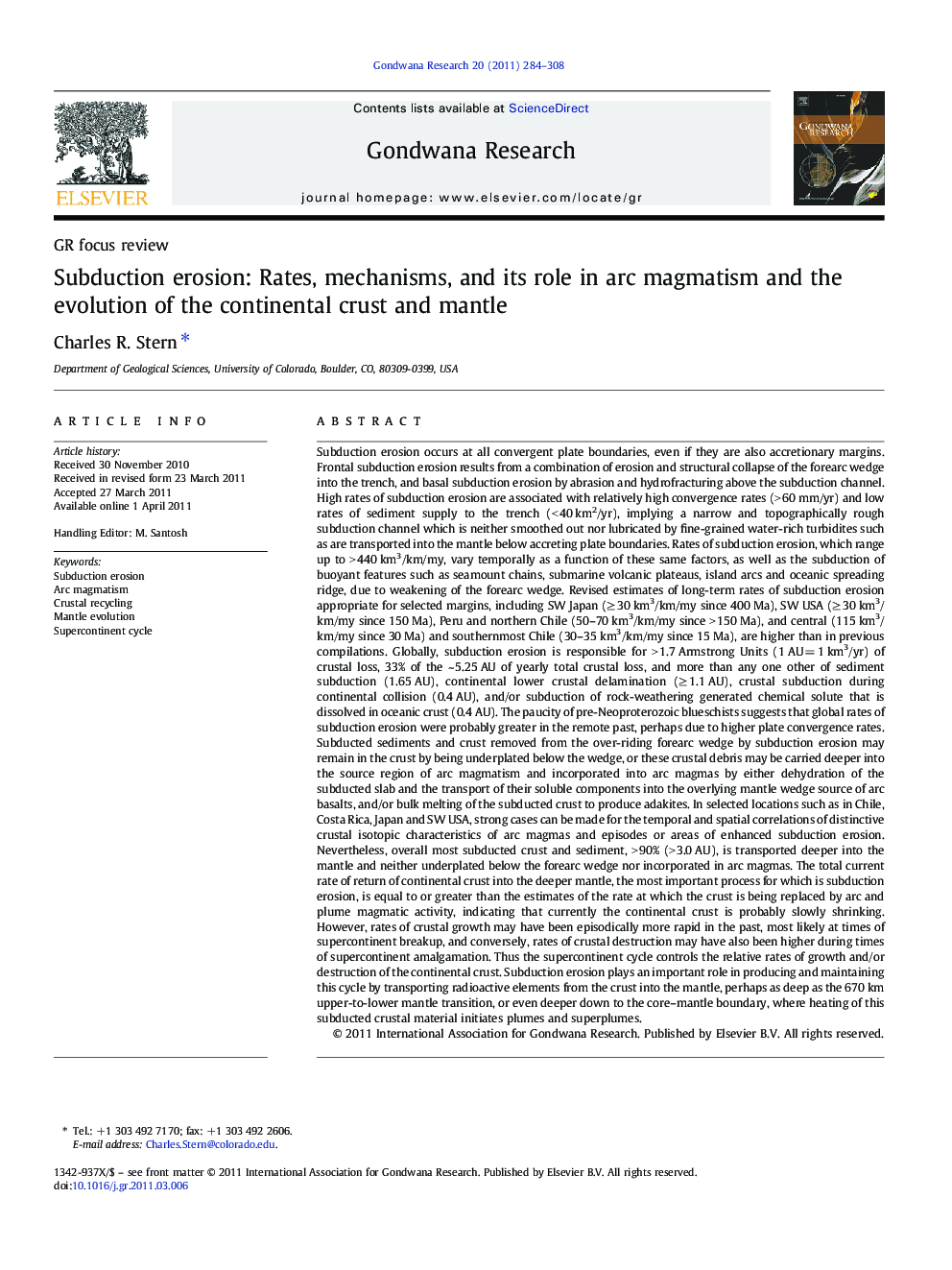| کد مقاله | کد نشریه | سال انتشار | مقاله انگلیسی | نسخه تمام متن |
|---|---|---|---|---|
| 4727695 | 1640147 | 2011 | 25 صفحه PDF | دانلود رایگان |

Subduction erosion occurs at all convergent plate boundaries, even if they are also accretionary margins. Frontal subduction erosion results from a combination of erosion and structural collapse of the forearc wedge into the trench, and basal subduction erosion by abrasion and hydrofracturing above the subduction channel. High rates of subduction erosion are associated with relatively high convergence rates (> 60 mm/yr) and low rates of sediment supply to the trench (< 40 km2/yr), implying a narrow and topographically rough subduction channel which is neither smoothed out nor lubricated by fine-grained water-rich turbidites such as are transported into the mantle below accreting plate boundaries. Rates of subduction erosion, which range up to > 440 km3/km/my, vary temporally as a function of these same factors, as well as the subduction of buoyant features such as seamount chains, submarine volcanic plateaus, island arcs and oceanic spreading ridge, due to weakening of the forearc wedge. Revised estimates of long-term rates of subduction erosion appropriate for selected margins, including SW Japan (≥ 30 km3/km/my since 400 Ma), SW USA (≥ 30 km3/km/my since 150 Ma), Peru and northern Chile (50–70 km3/km/my since > 150 Ma), and central (115 km3/km/my since 30 Ma) and southernmost Chile (30–35 km3/km/my since 15 Ma), are higher than in previous compilations. Globally, subduction erosion is responsible for > 1.7 Armstrong Units (1 AU = 1 km3/yr) of crustal loss, 33% of the ~ 5.25 AU of yearly total crustal loss, and more than any one other of sediment subduction (1.65 AU), continental lower crustal delamination (≥ 1.1 AU), crustal subduction during continental collision (0.4 AU), and/or subduction of rock-weathering generated chemical solute that is dissolved in oceanic crust (0.4 AU). The paucity of pre-Neoproterozoic blueschists suggests that global rates of subduction erosion were probably greater in the remote past, perhaps due to higher plate convergence rates. Subducted sediments and crust removed from the over-riding forearc wedge by subduction erosion may remain in the crust by being underplated below the wedge, or these crustal debris may be carried deeper into the source region of arc magmatism and incorporated into arc magmas by either dehydration of the subducted slab and the transport of their soluble components into the overlying mantle wedge source of arc basalts, and/or bulk melting of the subducted crust to produce adakites. In selected locations such as in Chile, Costa Rica, Japan and SW USA, strong cases can be made for the temporal and spatial correlations of distinctive crustal isotopic characteristics of arc magmas and episodes or areas of enhanced subduction erosion. Nevertheless, overall most subducted crust and sediment, > 90% (> 3.0 AU), is transported deeper into the mantle and neither underplated below the forearc wedge nor incorporated in arc magmas. The total current rate of return of continental crust into the deeper mantle, the most important process for which is subduction erosion, is equal to or greater than the estimates of the rate at which the crust is being replaced by arc and plume magmatic activity, indicating that currently the continental crust is probably slowly shrinking. However, rates of crustal growth may have been episodically more rapid in the past, most likely at times of supercontinent breakup, and conversely, rates of crustal destruction may have also been higher during times of supercontinent amalgamation. Thus the supercontinent cycle controls the relative rates of growth and/or destruction of the continental crust. Subduction erosion plays an important role in producing and maintaining this cycle by transporting radioactive elements from the crust into the mantle, perhaps as deep as the 670 km upper-to-lower mantle transition, or even deeper down to the core–mantle boundary, where heating of this subducted crustal material initiates plumes and superplumes.
Figure optionsDownload as PowerPoint slideResearch highlights
► Subduction erosion occurs at all convergent margins, subducting 1.7 AU of crust.
► Less than 10% of subducted crust is incorporated in arc magmas.
► Crust is shrinking, but rates of crustal growth/destruction are not steady-state.
Journal: Gondwana Research - Volume 20, Issues 2–3, September 2011, Pages 284–308